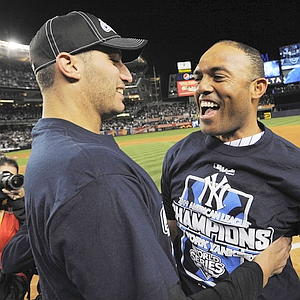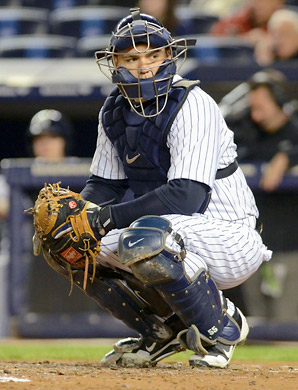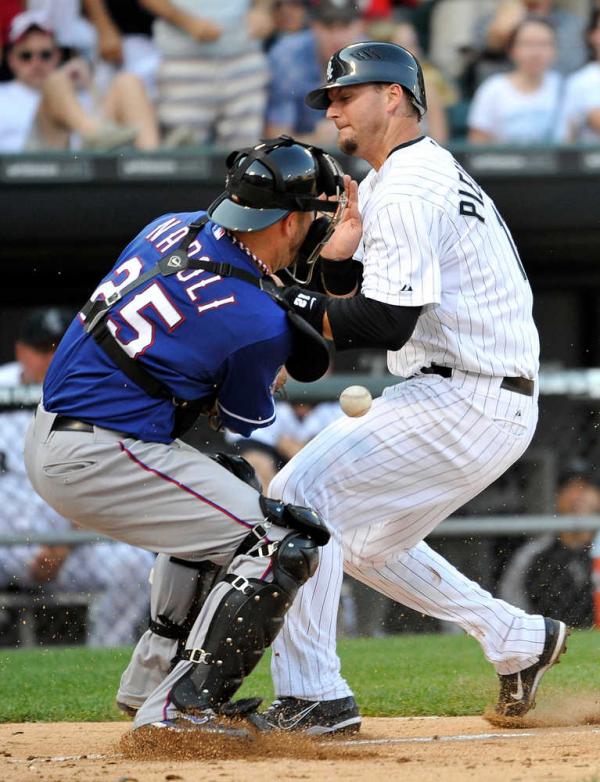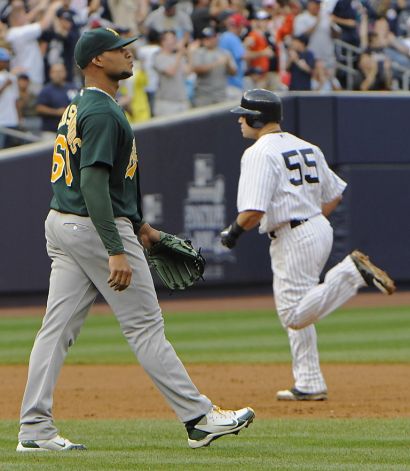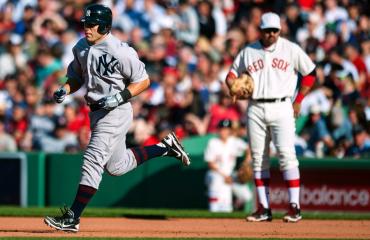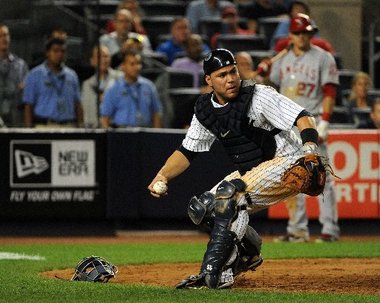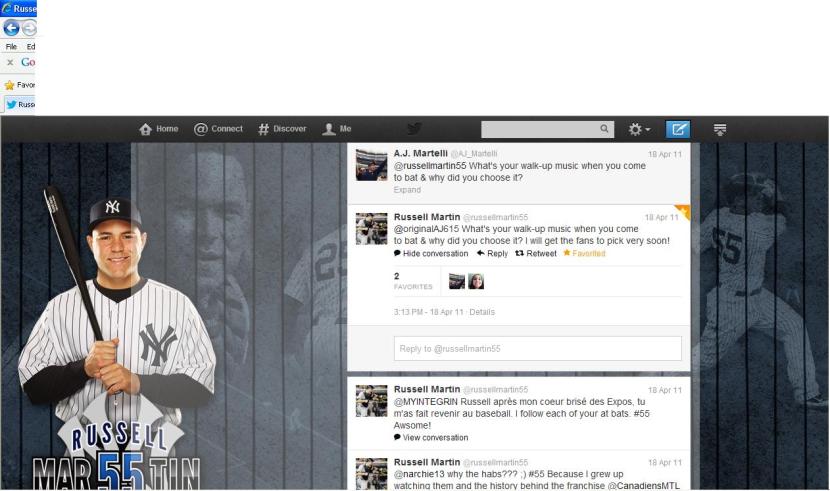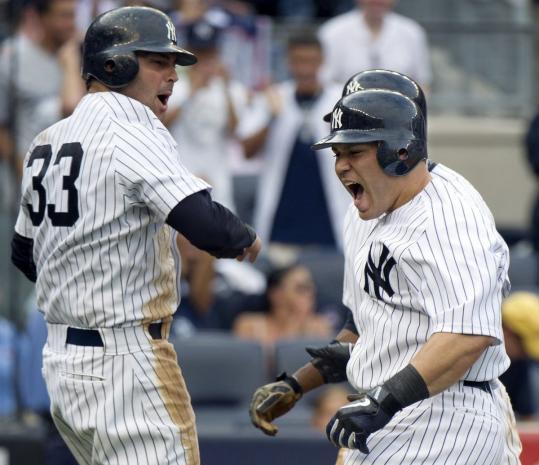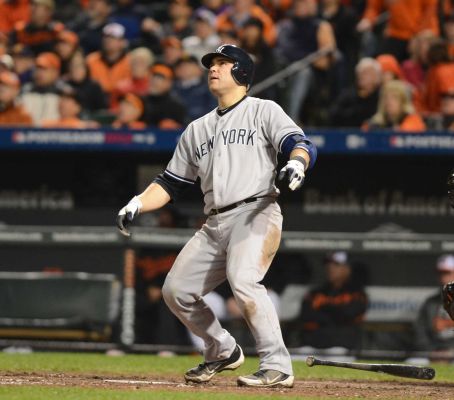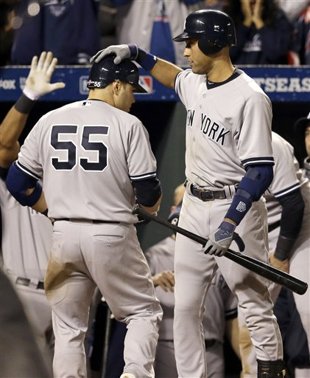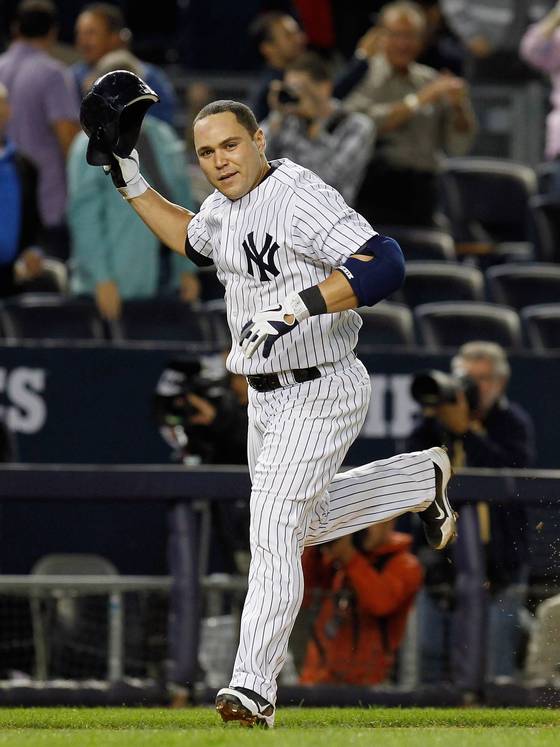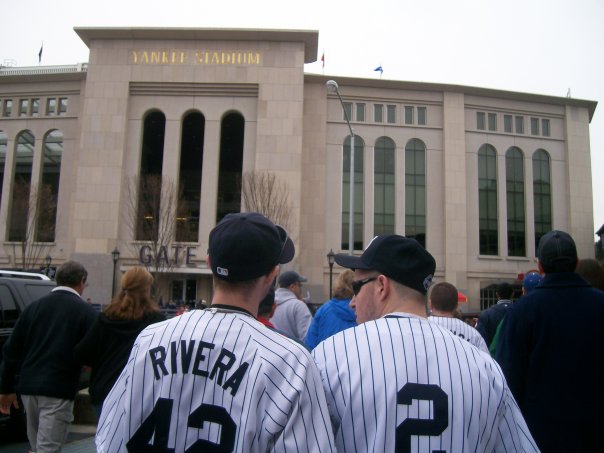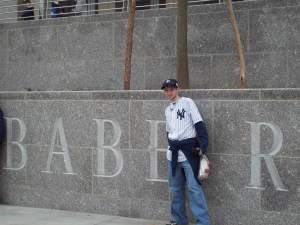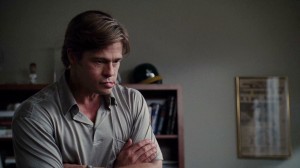Tagged: Oakland
Russell Martin’s Greatest Hits
The Yankees got some good news this week and some bad news.
The good? Crafty veteran Andy Pettitte and the greatest closer of all-time Mariano Rivera will indeed be pitching in the Bronx next season, the Yanks inking one-year deals with both hurlers. Pettitte was signed for $12 million for 2013 while Rivera was locked up for $10 million.
For one more year, the Bronx Bombers will be treated with each pitcher’s services. Yes, good.
The bad news? The Yankees lost their starting catcher, Russell Martin, to free agency last night. Martin agreed to terms with the Pittsburgh Pirates; a deal worth two years, $17 million.
Just like that, the Bronx Bombers are without a viable starting catcher.
It was quite surprising the Yankees didn’t at least pursue Martin in free agency, coming off a year in which he set a career-high in home runs with 21. His batting average (.211) may have been the lowest of his career, but the subpar BA shouldn’t have completely ruined his chances of returning.
Last year Pettitte came back on a dime, only signing for $2.5 million. The 40-year-old lefty was injured most of last season with a fractured ankle, as was the 43-year-old Rivera – who as we all know tore his ACL shagging fly balls on the warning track in Kansas City in May.
Martin, only 29 (although will be 30 on Feb. 15), (in this writer’s opinion) should have, at the very least, been offered something. Perhaps the Yanks could have given Pettitte and Rivera a little less – being that they’ll only be around for one more year, anyway – and reached out to the catcher for a deal.
Now, along with the likelihood of right fielder Nick Swisher not making a comeback and the Yankees needing to fill the void in the corner outfield spot, they will now need to seek an everyday backstop – which they’ll most likely be hard-pressed to do.
Right now their options include signing A.J. Pierzynski, a 35-year-old (36 on Dec. 30) with a history of not being the “nicest kid in class,” so-to-speak; striking a deal with Mike Napoli, the 31-year-old free agent who put up numbers somewhat similar to Martin’s in 2012 (.224 BA, 24 HR, 56 RBI); or just using Chris Stewart, Francisco Cervelli, and/or Austin Romine in 2013.
Stewart served as Martin’s backup last season, mostly working as CC Sabathia’s personal catcher, while Cervelli spent almost the entire season in the minors – not to mention Cervelli has suffered a number of concussions over the course of his young career. Romine also has an injury history and has not played a full Triple-A season his entire career.
Now the course of action is up to the Yankees’ front office; a catcher possibly on the Yankees’ wish list. In the meantime, I’d like to look back on a few of Martin’s best moments in pinstripes. Although he was only a Bomber for two years, he provided the team with jolts and boosts to make them a better ballclub in 2011 and 2012.
A part of history
The Yankees were off to a poor start vs. Oakland on the afternoon of Aug. 25, 2011. They had given the A’s a 7-1 lead by the third inning, the day looking like a lost cause; a stinker.
But Martin came up with a plan.
In the fourth inning he cut the lead down to 7-2 with a solo home run. Robinson Cano followed in the fifth with a grand slam to chop the lead to 7-6. Then in the sixth, Martin came up with the bases chucked and did Cano one better, crushing a grand slam of his own for his second homer in the game, giving the Yankees a 10-7 lead.
You would think the grand ol’ day was over, but there was more to come.
After Martin added another run on an RBI single as part of a six run seventh, Curtis Granderson smacked the Yankees’ third grand slam of the game in the eighth, the Yankees going absolutely wild on the way to a 22-9 win over the A’s. It was the first time a team had homered with the bases loaded in a single game three times in MLB history.
“It’s pretty amazing,” Martin told the media when it was over. “This game has been played for a long time. Pretty much everything has already happened. I’m waiting to see who’s going to hit four – I don’t know if it’s ever going to happen, but we’ll see. Three is pretty cool.”
Helping spoil the centennial
On April 20 the Yankees visited Fenway Park, joining the Red Sox in celebrating 100 years at 4 Yawkey Way in Boston. After a rather bizarre toast by former Red Sox Kevin Millar and Pedro Martinez, the Yanks got to work, putting some runs on the board and halting the BoSox behind the stellar pitching of Ivan Nova.
The Yanks basically had the game in the bag during the top of the sixth, up 5-2, but Martin added a run for good measure. The catcher clobbered a pitch off Clay Buchholz over the Green Monster – and over the Sports Authority billboard – a solo home run to give the Yanks a 6-2 lead to finish off the Red Sox.
Martin had already earned his pinstripes as a Yankee in 2011 when, towards the end of the season after a Yankee win over Boston, he said,
“We enjoy giving the Red Sox a hard time!”
Winning with the bat – and the arm
Martin had a rough go of it the first half of the 2012 season, only batting .179 before the All-Star break. Manager Joe Girardi even pulled him aside and spoke to him about his struggles, hoping his pep talk might turn his fortunes around.
And in the first game back from the All-Star break, he proved the tables had in fact been turned.
Against the Angels at home on July 13, Martin knocked in the go-ahead run with an eighth-inning RBI single. But his biggest contribution was yet to come.
With the Yanks leading 6-5 in the ninth, Howard Kendrick attempted to advance to second base on a ball in the dirt that almost got by Martin. But the catcher recovered nicely; picked up the ball and threw out Kendrick to end the game, propelling the Bombers to a win.
Sometimes it only takes one good game to give a player confidence going forward –and the solid effort certainly did give Martin confidence going into the second half of the season.
“I’m starting to feel a little bit better about myself,” he told the media afterward. “And that’s never a bad thing.”
A Twitter shout-out
This is more of a personal moment, but I’ll throw it in, nonetheless.
In April of 2011, Martin conducted a Twitter Q & A. Hoping to get some recognition, I sent him a tweet question. Little did I know he would respond to me! (Note: he answered me back when my handle was @OriginalAJ615)
(Follow me on Twitter @AJ_Martelli)
Walking off a hero
Twice this year, Martin made the most of clutch situations.
On June 10 after Rafael Soriano had blown a save vs. the Mets at home, Martin brought his big stick to the plate. Tied 4-4 in the ninth, he hammered a pitch off Jon Rauch deep to left field for a home run to not only lift the Yanks to a 5-4 victory over the Metropolitans, but a Subway Series sweep of their cross-town rivals.
Three months and 11 days later, it was the same story. This time however, vs. the Oakland A’s.
Tied 1-1 in the ninth on Sept. 21, Martin pounded another pitch to left; another solo, walk-off home run to beat the A’s 2-1 with one swing.
It’s safe to say Martin knew how to play the role of hero in 2012.
Leading the way in Game 1
The Yankees hadn’t beaten a team not named the Minnesota Twins in the ALDS since 2001, when they beat the A’s in five games. This year they were up against a familiar foe, the division rival Baltimore Orioles, in the first round of the playoffs, looking to finally quell a team other than the Twins in round one.
And it was Martin that set the table, playing a huge role in getting the Yanks out of the funk.
Knotted 2-2 in the ninth, the catcher broke the tie with a most impressive home run off Baltimore closer Jim Johnson, who had saved 51 games during the regular season – which led the majors. Martin’s round-tripper started a five-run rally for New York, as the Yanks went on to take Game 1 from the O’s, 7-2.
Yet it wasn’t just his offense that proved to be the difference.
Martin also made two remarkable plays on defense behind the plate in the fifth, preventing a pair of runs from coming in. It seemed he was just grateful to help the team win, no matter how.
“Whether I help the team win offensively or defensively,” he said, “I am happy.”
…………………………………………………………………………………………………
On behalf of Yankee fans everywhere, THANK YOU RUSSELL for the two years of service.
Best of luck in Pittsburgh. Tell A.J. Burnett and Jeff Karstens we say hi.
My First Trip to the New Yankee Stadium
This afternoon I found myself organizing a bunch of documents on my laptop. School assignments from my College years, newspaper articles from the school paper, and all of my recent work assignments were stockpiled in my computer folder.
I came across a personal experience story I had to write for my feature writing class in May of 2009. It should come as no shock that I wrote about my experience from the first trip I took to the new Yankee Stadium.
Reading this back, I felt like a little kid. It was priceless. I figured it might be nice to share it on here; put it on the blog. Most of the pictures in this entry are ones I shot that day.
Enjoy!….
I was exhausted as I looked out the window on the train ride home. As a die-hard baseball fan, I had just been through an absolute whirlwind. The day of my baseball-loving life.
Wednesday, April 22, 2009 was a very special day for me. I was privileged enough to make my first trip with my friends and family to the new Yankee Stadium.
In only the sixth regular season game at the new ballpark, the New York Yankees hosted the Oakland Athletics in an afternoon game.
Wearing my pinstriped Mariano Rivera jersey on my back and one of my many fitted Yankee caps on my head, I met up with my friends, Brian and Jenn, and my cousin Joe for what would be a memorable day.
On the train ride to the Bronx, we really did not know what to expect, other than a great time. I, for one, was not sure if the new Stadium would live up to the hype.
Sure, it looks incredible on television and in the newspapers, but how is it going look in-person? Will it be the same feeling as enjoying a game at the old Stadium? I couldn’t help but think.
We walked off the number four subway in the Bronx to an overwhelming site: The new Yankee Stadium in all its glory.
As we approached the building, we did not know what we were in for.
“The Kingdom of Heaven!” I exclaimed, while I was glaring at the building.
“This place looks absolutely amazing, and we are not even inside yet.”
The first thing we had to do was take pictures. I reached into my bag and pulled out my camera. I shot the façade of the stadium. I snapped pictures of the new Babe Ruth Plaza outside the Stadium.
And I got a picture of the new electronic game day board that read, “Oakland Athletics vs. New YorkYankees Today1:05.”
With seats in the bleachers, we were unsure of where to enter. If you had seats in the bleachers at the old Stadium, you could only enter through the back of the building. But we wanted to see everything in the new stadium. We walked up to Gate Six, and asked where to go.
“As long as you have your ticket, you can enter at any gate,” the gentleman informed us. “It doesn’t matter if you’re in the bleachers. We treat everybody equally at this Stadium!”
We happily entered the gate, right into the Great Hall. What I saw left me in disbelief. Yankees everywhere I looked.
“Wow,” I said in amazement. “I…I just can’t believe this. This place is unreal.”
Of course we had to take more pictures. My friends got a shot of me standing in the Great Hall with all the Yankee banners behind me.
Reggie Jackson. Paul O’Neill. Thurman Munson. Me. What a picture.
After walking around and snapping a ridiculous amount of photos, we finally settled into our seats. Left field bleachers, Section 236, row five, seat 16. That was mine.
It was about11:00 a.m.by the time we made it to the seats. The A’s were out on the field, stretching and taking batting practice.
I noticed so many baseballs fly out of the park. One flew right over our heads, landing about 20 feet away. Not long after that, one came within ten feet of Joe’s seat, landing directly in the glove of the kid next to him.
“Holy cow,” I said. “Pretty close!”
I then took a few minutes to take it all in. I looked at the frieze which now surrounds the top of the entire stadium. I looked out at the field. I looked at the flags around the top of the stadium, indicating the league standings.
“We are in second place right now,” I noted. “Right behind Toronto.”
And then I beheld the press box, which is located in the mezzanine behind home plate.
“I’ll be there someday,” I quietly said to myself.
“I just need my journalism degree, which I’ll be getting very soon, and a little bit of time to work my way up. I’ll be sitting up there with the rest of the writers, eventually.”
It had started to lightly rain during batting practice, and I began to feel very skeptical as to whether or not the game was going to be played. There was rain in the forecast, and I was not certain they were going to get it in.
But the grounds crew thought differently. They did not come out to put the tarp on the field. They chalked the lines and the batter’s box, raked the mound, and put the bases in, as if they were starting the game on time.
Then I noticed CC Sabathia chug from the dugout to the outfield to play long toss with the bullpen catcher. Pitching Coach Dave Eiland and Jorge Posada soon followed Sabathia out to centerfield.
I felt a little more confident now that the pitcher was warming up.
“If the game was not going to start on time, they would not have CC out there throwing,” I thought to myself. “We’ll see some baseball today.”
It got to be 1:00, and the P.A. announcer gave us the starting lineups. Oaklandfirst. The visitors are always announced first. Then the home team.
“…And for the Yankees: led by their manager, number 27, Joe Girardi. Batting first, the shortstop, number two, Derek Jeter!”
I could not contain myself as each Yankee was announced. I am a passionate Yankee fan, and I marked out for every single Yankee in the lineup.
“YAY, Derek! YAY Johnny! YAY BigTex!” …and so on.
Then came the National Anthem. And after the on-the-field warm-ups, the start of the game.
The first pitch was so exciting. Everybody was up and cheering. The roar of the crowd gets to you, even as a fan. I don’t know how the players handle it, but as a fan, it’s extremely intense.
After the first pitch, which was ball one from Sabathia, we heard it.
“YOOOOOO, Melky!!!!!”
“Bald Vinny,” the main bleacher creature who always sits in right field, started the Yankee roll call. He did this for every game in the old Stadium and apparently the tradition lives on.
“Some things will never change,” I said with a smile on my face.
I watched as the fans standing in the bleachers cried out for every Yankee until they were acknowledged. I could only laugh as I watched right fielder Nick Swisher turn around, face the bleacher creatures, and salute them, as if he was an Army soldier.
In the top of the second inning, Oakland catcher Kurt Suzuki slaughtered Sabathia’s offering to left field. Brian, Jenn, Joe and I all stood up as we gazed at the ball flying out to left field.
It carried far enough for a fan sitting in the front row to snatch the ball. He closed his glove and caught the ball for a three-run Oakland home run.
As the boos reverberated throughout the Stadium, Girardi came out to argue that the fan interfered.
“Here we go again,” I said. “Just like Sunday against Cleveland – bring on instant replay!”
The umps went into the tunnel for what seemed like only five minutes to decide whether or not the ball was a home run.
“Here come the umps,” Brian said to me as they walked from the third base tunnel out onto the field. “I hope it gets overturned!”
Third base umpire Brian Gorman twirled his index finger, signaling that the ball was indeed a goner. The Yankees were now down, 3-0.
A little depressed, we knew the Yankees needed a spark. Being down 3-0 early on in the game never puts any fan in a good mood.
But the bottom of the second inning lifted our spirits in a great way.
Hideki Matsui stepped up to the plate, and cracked a long, solo homer into the right field seats, putting us back within two runs.
“YES! I joyfully cried out. “We’re back in it!”
After Matsui’s blast, I high fived everyone around me, including two Yankee fans I had never met.
It doesn’t matter if you don’t know the other fans when a Yankee hits a home run. We’re all Yankee fans, which makes us family at the game.
“That’s what I’m talking about,” one of the fans said to me as I slapped his hand.
The next batter was Melky Cabrera. We had just seen one Yankee home run, and Cabrera made it two.
Back-to-back jacks – the first set of back-to-back home runs in the new house, in fact. Cabrera clobbered Oakland starter Brett Anderson’s offering into the area right below us.
Again, I yelled out, “YES! 3-2!”
While Cabrera rounded the bases, I borrowed Yankee announcer John Sterling’s cheesy catch-phrase and shouted, “The Melk-man always knocks twice!”
With the Yankees now trailing by only one run at the end of the second inning and the rain pouring down rather steadily, we had no choice but to leave our seats and take cover.
One of the best facets of the new stadium are the standing rooms. You can leave your seat, and still view the on-the-field-action.
Now protected from the rain and perched over the centerfield gate with Monument Park beneath us, we stood and watched Sabathia and the Yankees give up another run in the top of the third, making the score 4-2.
“Are you kidding me? This just is not right,” I told Joe while shaking my head in confusion.
Down 4-2, the Yankees received a much-needed lift in the bottom half of the third.
With Posada on second and Teixeira on third, Robinson Cano was able to push Teixeira across the plate for a run, bringing the Yanks back within one.
Soon after Nick Swisher came up and singled to drive in Posada, knotting the game at four runs apiece.
“Alright, we’re making some progress here,” I said as I peered out onto the field at the end of third inning.
“I have a gut feeling we’ll be on top when this game is all said and done.”
In the bottom of the fourth inning, we were treated to yet another Yankee home run. This time it was the Captain.
Jeter came up and blasted a solo home run directly below us in centerfield, taking the ball into Monument Park. If you looked closely enough on the replay, for a split second, you could just see the group of us cheering on the home run from the standing room platform above centerfield before it landed.
“Way to go, Captain! He did it again,” I gleefully exclaimed.
According to the scoreboard, Jeter was playing in his 2,000th career game. A home run must have been a nice way to remember it by.
Oakland would get a run back off Sabathia in the top of the sixth, as Mark Ellis singled to score Jack Cust.
I could hear the other fans’ disgust at Sabathia’s pitching.
“Why does this guy suck? He’s terrible,” I heard one upset fan say.
“Go back toMilwaukee, you waste of money,” I heard another disgruntled fan cry out.
The bad feelings towards Sabathia temporarily evaporated in the bottom of the sixth, as the Yankees re-took the lead.
Tied at five, Jeter doubled to score Cody Ransom, and Teixeira singled to score Jeter, giving the Bronx Bombers a 7-5 edge.
“This is real Yankee baseball,” I thought to myself. “It doesn’t matter how bad CC is, as long as the offense does its job.”
With the Yanks up by two at the end of six, we decided to leave the standing area and see the rest of the palace.
The new stadium offers so much, and there’s a lot to see and do. We heard that there was museum inside the ballpark, open to the fans. We asked around, and found out that we had just enough time to visit the museum before it closed.
So we went.
We walked in the Yankee museum, and just as I had been blown away coming off the subway, I was taken aback by everything in the room. There was so much to see.
We took pictures with the World Series trophies from the 1996, 1998, 1999, and 2000 Championship years. The years I fell in love with the Yankees and with baseball.
I couldn’t help but think of the great teams of those years, and how much I loved watching them at the old Stadium.
“I remember when Tino Martinez crushed that grand slam into the upper deck in right field in first game of the ’98 series,” I said to Brian.
“Tino was one of the greatest players to ever put on the pinstripes, and my favorite during the dynasty.”
Then we made our way to the “ball wall,” an incased shelf of baseballs autographed by practically every player ever to wear a Yankee uniform.
I was amazed, saying to my friends and cousin, “Hey, look here’s Yogi! Oh man, it’s Jeter’s ball. And here’s Tino’s! And the greatest player to ever live: Babe Ruth.”
After viewing the ball wall, we journeyed over to the replica clubhouse locker. You can type your name into the computer, and it will appear above the locker, as if you are in the Yankee clubhouse as a player.
I typed my name in, and it appeared.
“A.J. Martelli” appeared above the locker, much to my delight.
I thought to myself, “This is what it feels like to be a Yankee. It feels pretty good.”
Of course, I got a picture of me in the locker with my name posted over my head to remember it by.
As all this was going on, we noticed on the high definition television screen that Sabathia was blowing the lead.
Ex-Yankee and current Athletic Jason Giambi grounded out to short while Bobby Crosby scored, and Matt Holliday singled to score Ryan Sweeney, knotting the game again, this time at seven.
Sabathia exited to a mixed reaction from the Yankee faithful, and those bad feelings toward him from the sixth inning came back.
We made our way out of the museum, and back to a standing area, this time by first base.
We could only look on as the Yankees and A’s could not get anything offensive going. With the game still knotted at seven heading into the top half of the ninth, we watched Mariano Rivera come in to pitch.
As Metallica’s “Enter Sandman” blared through the new stadium speakers and Rivera dashed in from the bullpen, it all looked so different to me.
“It’s so weird to see him enter from right field,” I said. “I’m so used to seeing him come in through the left field gate.”
The new Stadium features the Yankee bullpen behind the right field fence, in contrast to the old Stadium, where it sat behind left-center.
Rivera mowed through the A’s in the top of the ninth. The Yankees could not generate a winning run in the bottom of the ninth, and the game went into extra innings.
The 11th. The 12th. The 13th. After awhile we found ourselves completely wiped out.
With our legs tired and already harboring a seven and a half-hour day at the stadium, we contemplated whether or not to stay or hit the subway back to Grand Central.
“If they don’t win after the 13th, you want to head out?” I asked.
“We are all really tired, I don’t care what we do,” said Brian.
“I just hope they win, either way!”
With sore legs from walking, a horse voice from cheering, and a tired mind, my friends, my cousin, and I made our way back to the subway.
Many others had the same idea, as the subway was crammed with Yankee fans.
“Was this your first game at the new stadium?” a man wearing a Yankee hat sitting across from me asked.
“Yeah,” I replied.
“How’d you like it?” he followed up.
“It was amazing. I can’t believe how stunning the Stadium really is. The television does not do it justice. You have to come down here and physically enter the building to really appreciate it,” I again replied.
He agreed with everything I said.
When we reached Grand Central, we found that the Yankees were still playing in the top of the 14th inning.
We finally boarded the train back home, exhausted and worn out. However, I was not going to rest until I found out if the Yankees had won or lost.
Strangely enough, I looked out the train window as we passed the Stadium on the way home. Staring in awe at the ballpark from the train, I received a text message from another friend, Micheal.
“Melky just hit a walk-off homer in the bottom of the fourteenth. Yankees win!”
As I was glaring at the “Kingdom of Heaven” from the train, the Bronx Bombers were celebrating at home plate, mobbing Cabrera in a 9-7 Yankee victory. The first walk-off home run in the new Yankee Stadium. History.
I smiled, and knew that even though we didn’t exactly see the game-winner, it was like I did.
I was satisfied knowing that I’ll always remember my first trip to the new stadium. I was just an infant when my parents took me to my first game in the old stadium. I can’t exactly remember that first visit to the old ballpark vividly.
But now I’ll have memories that will last for the rest of my life. Memories from my first trip to the new Stadium that I’ll remember forever.
Exhausted and staring out the window as we passed Dobbs Ferry, I finally shut my eyes.
The Yankees won. Now I could rest easily.
Baseball Business on the Big Screen: A Review of “Moneyball”
Peter Brand: It’s only been a few days. You have to give yourself some time to get over it.
Billy Beane: I don’t get over these things. Ever.
After nearly beating the god-like New York Yankees in the 2001 American League Division Series, all hope seems to be lost for Oakland Athletics’ General Manager Billy Beane (Brad Pitt). He loses three of his key players to free agency – Jason Giambi, Johnny Damon, and Jason Isringhausen – and is forced to rebuild the A’s.
Beane travels to Cleveland to discuss potential trades with the Indians’ General Manager when he discovers Peter Brand (Jonah Hill). Brand is a player analyst whose opinion is valued by the Cleveland brass. Beane recognizes that and instead of gaining a player, buys Brand from the Indians and hires him as the assistant GM.
Together Beane and Brand use a philosophy no other team had ever utilized: signing players who are not necessarily power hitters, players who hit for average or players who rack up a great number of RBIs, but possess the ability to get on base.
They sign players who are on the downside of their careers, like David Justice, Jeremy Giambi, and Scott Hatteberg. Each of these players lack many of the tools needed to play the game, but have one thing in common: high on-base percentages.
Beane’s logic is simple: it doesn’t matter how you get on base. If you get on base, you’ll score runs. The strategy doesn’t sit too well with manager Art Howe (Philip Seymour Hoffman) and the two clash, disagreeing about necessary decisions such as who is in the lineup.
Although Oakland started the ’02 season slow, they eventually won 20 games in a row, setting an American League record for most consecutive wins in a single season.
The A’s overcome the odds and make the postseason, but get bumped in the first round for the second year in a row, this time by the Minnesota Twins. In the midst of the early playoff exit, the Red Sox recognize what Beane did in terms of building his team. Boston owner John Henry offers Beane a contract to be the highest paid General Manager in baseball history, which he declines.
Instead of going to the Red Sox, Beane opts to remain with the A’s, only for the Red Sox to win the World Series two years after he turned them down – winning it all by using the philosophy Beane instituted in Oakland.
There are a few unique baseball movies out there, but “Moneyball” just might be the most unique. Based on a true story, it isn’t a coming of age flick like “The Sandlot” or a one last chance tale like “The Rookie.”
“Moneyball” is a movie that presents and exposes the business side of the game of baseball – a side of the game that isn’t always transparent to the average fan.
Right from the start of the movie you are taken into the corporate side of baseball when Beane goes to Cleveland to try and make immediate off-season moves. It really shows you how fast things happen when a baseball team’s season ends. Most people might get the impression that once the season is over the next time the team is worrying about anything is Spring Training.
That notion is quickly proved wrong right at the start of the movie.
Beane’s assistant Brand is based off Paul DePodesta, a savvy baseball expert who studied the game in and out and served as a catalyst in terms of changing the team. He enforced and supported building the A’s team by way of sabermetrics, which is defined as a system of analyzing baseball players by empirical evidence and specific in-game activity.
Bill James, a baseball writer and statistician, was “the man behind the curtain” so-to-speak, as he devised this crazy concept of sabermetrics. In fact, James wrote the book from which the movie is adapted. His ideas were was embraced by the Oakland General Manager. Beane knew exactly what he was hoping to accomplish and it shows throughout the movie.
One of the best and most relatable scenes in the movie to me was the scene that portrayed Brand breaking some potentially unsettling news to Carlos Pena. Beane had told his assistant that he might have to tell players they are cut or traded, as it comes with the job; a classic case of a boss making his employee do some not-so-fun work.
Ultimately Brand had to inform Pena that he had been traded to the Detroit Tigers.
Right as that scene concluded, I immediately thought of my internship with the Hudson Valley Renegades, a Single-A team affiliated with the Tampa Bay Rays. I interned for them over the summer of 2010 and at times they would ask the interns to do some bizarre things.
One night the Renegades were playing the Jamestown Jammers, whose parent club is the Miami Marlins. One of the Jammers had been cut that day, but was still at the Stadium. He needed to be driven to the airport and they selected an intern (it wasn’t me) to give him a ride.
I saw a little bit of a parallel between the scene in the movie and the instance from my internship.
Something else I found interesting was the scene portraying the acquisition of reliever Ricardo Rincon. At the beginning of the movie when Beane is in Cleveland, he inquires about Rincon and expresses a sheer amount of interest in him. At the trade deadline the Indians are out of the playoff running. With the A’s still in contention and in need of a reliever, Beane gives the Tribe a call.
Cleveland refused to budge on a swap for Rincon citing interest from other teams, so Beane takes matters into his own hands. He orchestrates a ploy with some of the other General Managers and in the end lands the deal and acquires Rincon.
If I could take one still frame from the entire movie, it would be Brand’s reaction after he and Beane pulled off the trade. He looked like a little kid at Christmas, getting exactly what his heart desired.
What I also liked was how they threw in the little back story about Beane’s career as a player. He was drafted by the New York Mets out of high school, and instead of going to Stanford to play baseball on a full-ride scholarship he chose to sign with the Mets.
And it didn’t go well for Beane. At all.
His career was a flop and it kind of goes back to the idea of whether it’s smart to play in college or go right to the pros upon getting drafted. I’ve always had more respect for the ones that play in college. I feel you have a better chance at maturing as a player and as a person.
It certainly worked out for someone like Tino Martinez, who was drafted out of high school by the Red Sox, yet turned them down to play for the University of Tampa. He was drafted again by Seattle and eventually had a wonderful career.
At any rate, there are a few things I noticed while watching “Moneyball” that I was sort of able to nitpick at; things that didn’t make the movie any less enjoyable, but once I noticed them I picked them out.
For one, in the Ricardo Rincon trade scene, Brand is wearing an all-green Oakland A’s hat. The all-green hats, complete with black underneath the bill, weren’t introduced until 2007 when New Era released the polyester headwear to reduce sun glare. Up until then, grey was the color underneath the bill of the hat.
I only knew that because when the polyester caps were released (it should come as no shock) I purchased a Yankee hat.
In addition to the hat anachronism, the scene which portrays Beane at Fenway speaking to Henry caught my eye. Boston’s 2004 and 2007 championship banners are visible. The movie is taking place at the conclusion on the 2002 season, so the flags representing Boston’s titles shouldn’t be there.
At first I thought I had spotted another mistake, but as it turns out the director (Bennett Miller) got it right.
The scene in which the A’s were gunning for their 20th consecutive win, they are shown playing the Kansas City Royals at home. They show Mike Sweeney hit a towering drive to left field, homering to put the Royals within one run; KC eventually tying the game before the A’s picked up the 12-11 win on the power of a walk-off, solo home run off the bat of Hatteberg.
When Sweeney played, he wore a “C” on his jersey, denoting his status at team captain. In the movie Sweeney’s “C” was absent from the breast of his jersey, but it should have been. Upon research, he wasn’t named captain of the Royals until 2003.
I thought I had caught Miller on a mistake, but in the end he got me.
Overall I found “Moneyball” to be a riveting and informative movie. I wish I had seen it sooner than I had, but when it was in theaters last summer most of my friends went and saw it with their girlfriends. Naturally when I wanted to see it and asked my friends to go to the movies, I only heard the words,
“I already saw it with my girlfriend. It was really good, you should go see it.”
Yes, I should have gone to see it when it was in theaters. But I wasn’t going to the movies by myself.
Where’s the fun in that?
